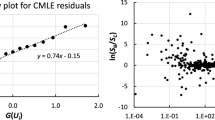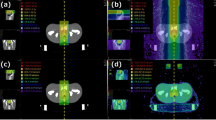Abstract
This study is based on our already published experimental data (Kowalska et al. in Radiat Environ Biophys 58:99–108, 2019) and is devoted to modeling of chromosome aberrations in human lymphocytes induced by 22.1 MeV/u 11B ions, 199 MeV/u 12C ions, 150 MeV and spread-out Bragg peak (SOBP) proton beams as well as by 60Co γ rays. The curvature of the dose–effect curves determined by the linear-quadratic model was considered in the frame of a simple analytical approach taking into account increase in the irradiation dose due to overlapping interaction regions of ion tracks. The model enabled to estimate effective interaction radius which could be compared with the physical expectations. The results were also compared to the Amorphous Track Structure Model of Katz which allows to get some additional information about the ion track structure. The analysis showed that the curvature of the experimental dose–effect curves mainly results from highly efficient repair processes of the DNA damage.



Similar content being viewed by others
References
Ando K, Goodhead DT (2016) Dependence and independence of survival parameters on linear energy transfer in cells and tissues. J Radiat Res 57:596–606
Ballarini F, Altieri S, Bortolissi S, Carante M, Giroletti E, Protti N (2014) The BIANCA model/code of radiation-induced cell death: application to human cells exposed to different radiation types. Radiat Environ Biophys 53:525–533
Chatterjee A, Schaefer HJ (1976) Microdosimetric structure of heavy ion tracks in tissue. Radiat Environ Biophys 13:215–227
Cucinotta FA, Nikjoo H, Goodhead DT (1999) Applications of amorphous track models in radiation biology. Radiat Environ Biophys 38:81–92
Elsässer T, Krämer M, Scholz M (2008) Accuracy of the local effect model for the prediction of biologic effects of carbon ion beams in vitro and in vivo. Int J Radiat Oncol Biol Phys 71:866–872
Friedland W, Kundrat P (2013) Track-structure based modelling of chromosome aberrations after photon and alpha-particle irradiation. Mutat Res 756:213–223
Friedland W, Schmitt E, Kundrat P, Digfelder M, Baiocco G, Bariberi S, Ottolenghi A (2017) Comprehensive track-structure based evaluation of DNA damage by light ions from radiotherapy-relevant energies down to stopping. Sci Rep 7:45161
Friedrich T, Scholz U, Elsässer T, Durante M, Scholz M (2012) Calculation of the biological effects of ion beams based on the microscopic spatial damage distribution pattern. Int J Radiat Biol 88:103–107
George K, Hada M, Cucinotta F (2015) Biological effectiveness of accelerated protons for chromosome exchanges. Front Oncol 5:226
Katz R (1978) Track structure theory in radiobiology and in radiation detection. Nucl Track Detection 2:1–28
Katz R (1988) Radiobiological modelling on track structure. In: Kiefer J (ed) Quantitative mathematical models in radiation bioogy. Springer, Berlin, pp 57–83
Katz R, Ackerson B, Homayoonfar M, Sharma SC (1971) Inactivation of cells by heavy ion bombardment. Radiat Res 47:402–425
Kowalska A, Czerski K, Nasonova E, Kutsalo P, Krasavin E (2017) Radiation dose-response curves—cell repair mechanisms vs probability of ion track overlapping. Eur Phys J D 71:332
Kowalska A, Pereira W, Czerski K (2018) Fano factor of chromosome aberrations and assessment of repair efficiency. Acta Phys Polonica A 133:225–227
Kowalska A, Czerski K, Nasonova E, Kutsalo P, Pereira W, Krasavin E (2019) Production and distribution of chromosome aberrations in human lymphocytes by particle beams with different LET. Radiat Environ Biophys 58:99–108
Lee R, Nasonova E, Hartel C, Durante M, Ritter S (2011) Chromosome aberration measurements in mitotic and G2-PCC lymphocytes at the standard sampling time of 48 h underestimate the effectiveness of high-LET particles. Radiat Environ Biophys 50:371–381
Loucas BD, Durante M, Bailey SM, Cornforth MN (2013) Chromosome damage in human cells by γ rays, α particles and heavy ions: track interactions in basic dose-response relationships. Radiat Res 179:9–20
Savage JRK (1975) Classification and relationships of induced chromosomal structural changes. J Med Genet 12:103–122
Scholz M (2006) Dose response of biological systems to low- and high-LET radiation. In: Horowitz Y (ed) Microdosimetric response of physical and biological systems to low- and high- let radiations: theory and applications to dosimetry, 1st edn. Elsevier, Amsterdam, pp 3–68
Scholz M, Kraft G (1996) Track structure and the calculations of biological effects of heavy charged particles. Adv Space Res 18:5–14
Surdutovich E, Solov’yov AV (2018) Calculation of survival probabilities for cells exposed to high ion fluences. Eur Phys J D 72:140
Tello et al (2018) Proximity effects in chromosome aberration induction: dependence on radiation quality, cell type and dose. DNA Repair 64:45–52
Acknowledgements
We thank the staff of the Medical Centre of JINR and Flerov Laboratory of Nuclear Reactions, JINR, for supporting the accelerator studies, as well as Golubev A.A. and Markov N.V. (ITEP, Moscow, Russia) for providing the opportunity of carbon irradiation at the ITEP-TWAC accelerator and Dr. T. Friedrich (GSI, Darmstadt, Germany) for the evaluation of spatial dose distributions presented in Fig. 1.
Author information
Authors and Affiliations
Corresponding author
Ethics declarations
Conflict of interest
The authors declare that they have no conflict of interest.
Additional information
Publisher's Note
Springer Nature remains neutral with regard to jurisdictional claims in published maps and institutional affiliations.
Rights and permissions
About this article
Cite this article
Czerski, K., Kowalska, A., Nasonova, E. et al. Modeling of chromosome aberration response functions induced by particle beams with different LET. Radiat Environ Biophys 59, 79–87 (2020). https://doi.org/10.1007/s00411-019-00822-0
Received:
Accepted:
Published:
Issue Date:
DOI: https://doi.org/10.1007/s00411-019-00822-0




